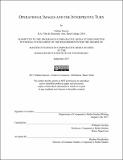| dc.contributor.advisor | William Uricchio. | en_US |
| dc.contributor.author | Saucier, Nathan (Nathan W.) | en_US |
| dc.date.accessioned | 2018-02-08T15:58:35Z | |
| dc.date.available | 2018-02-08T15:58:35Z | |
| dc.date.issued | 2017 | en_US |
| dc.identifier.uri | http://hdl.handle.net/1721.1/113459 | |
| dc.description | Thesis: S.M., Massachusetts Institute of Technology, Department of Comparative Media Studies/Writing, 2017. | en_US |
| dc.description | This electronic version was submitted by the student author. The certified thesis is available in the Institute Archives and Special Collections. | en_US |
| dc.description | "September 2017." Cataloged from student-submitted PDF version of thesis. | en_US |
| dc.description | Includes bibliographical references (pages 105-109). | en_US |
| dc.description.abstract | Over the past several decades, computers have allowed for the increasingly voluminous and rapid ingest of images. These images, made for machine legibility, are called "operational images," a term coined by Harun Farocki. They are made for machines, by machines; they are not made to represent an object, but are part of an operation. Yet these operational images are only the most recent chapter in a longer history of logistical and instrumental use of images. Through the history of cartography, surveillance, and reconnaissance runs a long tale of instrumentalization, a history of calculable images primed for machine-readability. Before computers allowed for a truly "operational" image that could be harvested and interpreted independently, there were many other logistical images -- only these predecessors kept humans in the operational loop. These days, so-called deep learning allows for a new development in the operational image -- not only are humans excluded, but machines are performing inscrutable assessments; they interpret images and provide conclusions while their rationales remain opaque. These images are part of an interpretive turn. This sort of image use is difficult to demystify, confront, and confound. To contemplate effective strategies, it helps to look at the broader context of subversion of the logistical image, reaching back to early instances of artistic intervention to help inform the present and future. | en_US |
| dc.description.statementofresponsibility | by Nathan Saucier. | en_US |
| dc.format.extent | 109 pages | en_US |
| dc.language.iso | eng | en_US |
| dc.publisher | Massachusetts Institute of Technology | en_US |
| dc.rights | MIT theses are protected by copyright. They may be viewed, downloaded, or printed from this source but further reproduction or distribution in any format is prohibited without written permission. | en_US |
| dc.rights.uri | http://dspace.mit.edu/handle/1721.1/7582 | en_US |
| dc.subject | Comparative Media Studies. | en_US |
| dc.title | Operational images and the interpretive turn | en_US |
| dc.type | Thesis | en_US |
| dc.description.degree | S.M. | en_US |
| dc.contributor.department | Massachusetts Institute of Technology. Program in Comparative Media Studies/Writing | |
| dc.identifier.oclc | 1020252097 | en_US |
